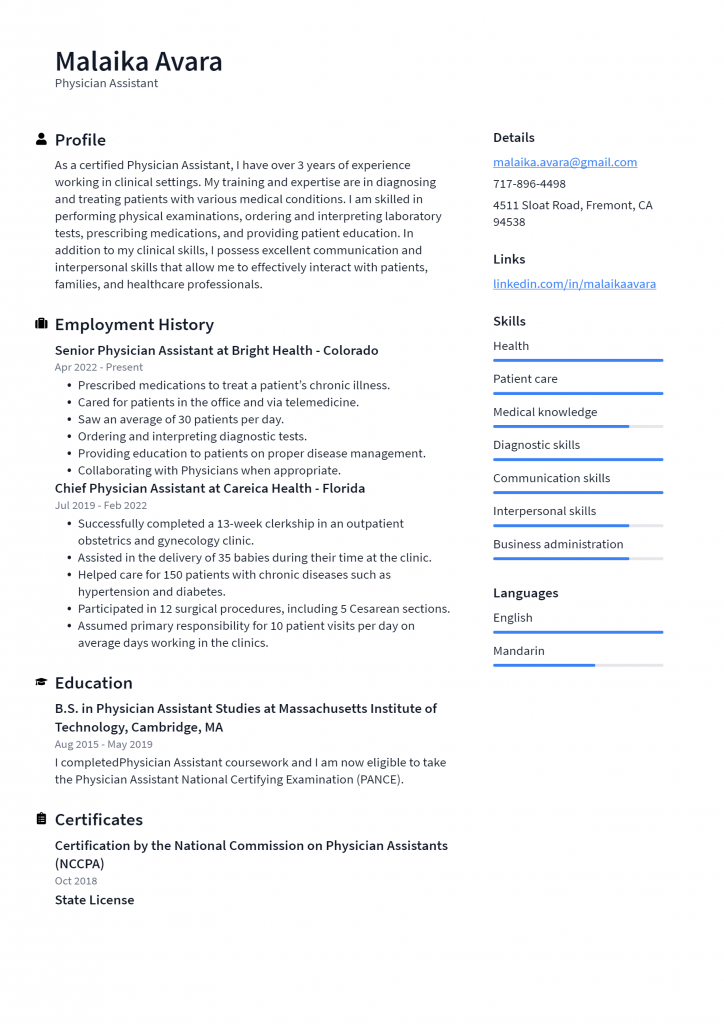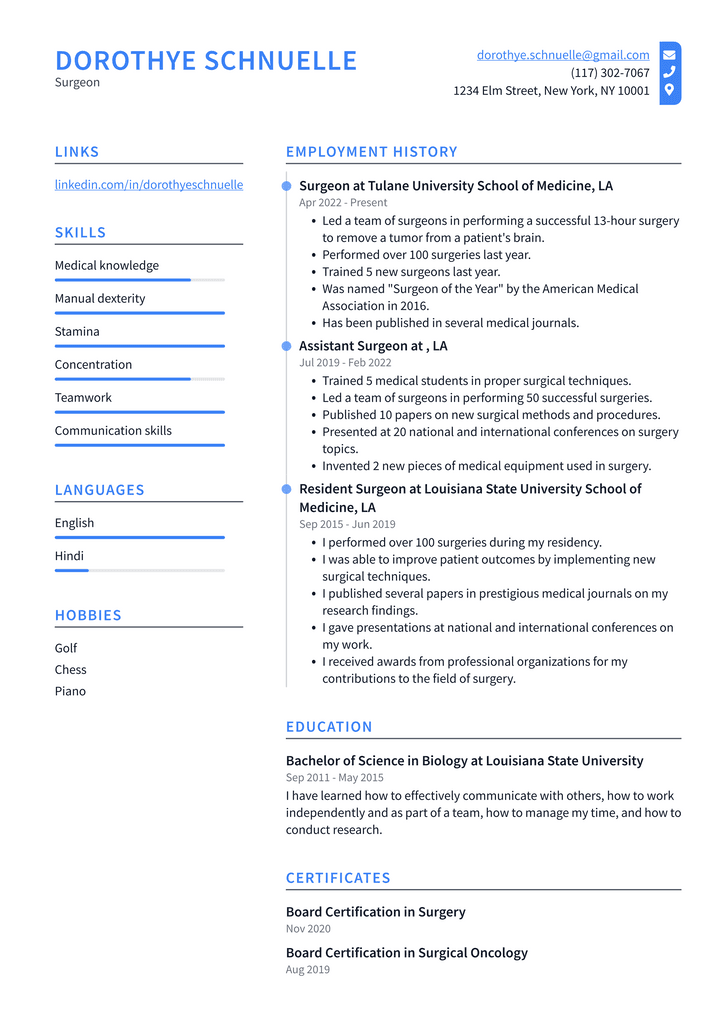A physician assistant (PA) is a healthcare professional who works with physicians to diagnose and treat patients. The PA can conduct physical examinations, take patient histories, order diagnostic tests, and counsel patients on healthy eating habits and lifestyle changes. The role of a physician assistant has been increasing in the healthcare industry in recent years. And this has created ample opportunity for aspiring PAs to find work in this field. However, landing an interview for any job can be challenging, much less so when trying to get hired as a PA. Your resume is your first impression when applying for any job — especially one that requires an advanced degree, like being a PA. A well-written resume will give you the best chance of getting noticed sooner rather than later by that prospective employer. Keep reading to learn more about what makes a strong resume for PAs and helpful tips for putting together your standout document.
Physician Assistant Resume Example

Download This Physician Assistant Resume as PDF
Nurse Resume Example

Download This Nurse Resume as PDF
Paramedic Resume Example

Download This Paramedic Resume as PDF
Physician Resume Example

Download This Physician Resume as PDF
Emergency Medical Technician Resume Example

Download This Emergency Medical Technician Resume as PDF
Medical Assistant Resume Example

Download This Medical Assistant Resume as PDF
Surgeon Resume Example

Download This Surgeon Resume as PDF
Resume Basics for PAs
Before we get into the specifics of how you should craft your physician assistant resume, let’s first review some resume basics. Most traditional job applications now list “electronic” or “online” as the preferred method of receiving and reviewing applications. As a result, almost all employers expect you to submit your resume as an attachment with a standard file type (like .doc or .pdf). You may also be asked to provide a cover letter with your resume, especially if you’re applying to an organization that highly values professional communication. If a cover letter is expected, it’s generally accepted to write one that is no longer than one full page. Therefore, when writing your resume, it’s best to keep it to one page. There are, however, a few specific exceptions to this rule. If you’ve been out of school for a long time and are applying to a super-selective employer, you’ll likely need to go a little longer.
Choosing the Right Format
Physician assistant resumes can be formatted for a few different industries of healthcare. It would help if you formatted your resume to match the job industry and position you’re applying for. For example, when using to work in a hospital setting, your resume should be formatted as a “nursing resume.” On the other hand, you should format your resume as an “administrative assistant resume” in an office setting. Physician assistant resumes can also be formatted as a combination resume. A combination resume contains elements of both nursing and an administrative assistant resume. This option is less common but can make sense for some PAs. For example, if you have extensive clinical experience as a PA and a few years of administrative experience, you could include both relevant sections on your resume.
Including Your Educational Background
All education sections start with the school’s name, degree, and year of completion. The following line is the name of the institution where you earned the degree. The name of the degree should be in bold. For example, a third line could read “concentration” or “major.” The last part of this section should be the overall GPA/grade point average (no letters or numbers, just a number). For example, if you have a GPA of 3.8, you should put “3.8”. Depending on your level of education (if you’re just a student or if you’ve been out of school for many years), you might choose to list your GPA or your overall grade point average. If you’re a student, you may want to list your GPA to show potential employers that you’re on track to earn a good GPA. On the other hand, if you’ve been out of school for a long time, you might choose to list your overall GPA instead. This can be helpful if you were an average student in college and aren’t sure how to present that information to a prospective employer.
Including Key Skills
This section should list any skills relevant to the role of a PA. Examples of skills you may want to include on your resume for PAs include – Computer skills – Critical thinking – People management – Communication skills – Time management – Writing – Interpersonal skills – Leadership – Education. If you have several skills that are particularly relevant to the PA job description, feel free to list them all. However, if you have a few relevant skills and a few that aren’t, it’s best to focus on the most relevant skills only. Don’t get too caught up in trying to fit everything you’ve ever done into one resume. Remember, you’re trying to highlight the most relevant skills and experiences for your application job.
Including Clinical Experience
The most important thing to remember when listing your clinical experience is to ensure you’re being accurate and honest. You want to avoid documenting clinical experiences that you didn’t do. This could appear on a background check and be a red flag for an employer. Of course, you also don’t want to undersell yourself. If you were a “primary patient care provider,” you should list that on your resume. If you’ve been out of school for a long time and worked mainly in an administrative role, listing clinical experience on your resume for PAs can be challenging. If this is the case for you, your best bet is to include a short statement that explains any gaps in your clinical experience. Here’s an example: “After working as an EAP counselor, I decided to pursue a career in healthcare and enrolled in a Physician Assistant Program. I graduated in 20XX and have been working clinically as a PA since 20XX.”
Including Other Relevant Experience
Along the same lines as clinical experience, you may want to consider including a short statement about any gaps in your work history. Here’s an example: “I am currently employed as a Project Manager at ABC Company. Before that, I worked as an EAP counselor for two years.” If there are gaps in your work history, it’s essential to explain them. Employers are often curious about these breaks in employment and usually want to know if they’re a cause for concern.
Conclusion
A physician assistant resume is only one part of the job application process. You’ll also need to write a cover letter, apply online (if applicable), and sometimes participate in an interview. The best way to prepare for all these application parts is to do your research. Learn as much as possible about the company you’re applying to and the job itself. You can also do a few mock interviews with a friend to help build your confidence and help you prepare for the actual interview you hope to have. Once you’ve done all this, you’ll have a powerful application that gives you the best possible chance of getting hired as a PA.